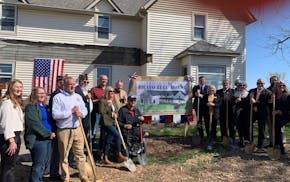A $7 million funding shortfall facing parks agencies in the metro area is drawing a very different reaction from two south-of-the-river counties eager to expand their holdings.
Scott County, which managed to eke out a big grant just before one funding stream ran dry, is optimistic about the chances of pulling through the nose-dive.
Dakota County, though, is steaming.
In the oddly incongruous setting of a meeting room whose giant sun-washed windows overlooked hordes of cheerful families touring Como Park Zoo, Dakota's parks chief last week delivered a long, emphatic message to the regional group that oversees parks funding.
An outdated scheme to pay for new parkland, Steve Sullivan warned, is threatening to get in the way of a delicate dance that counties engage in with longtime landowners in hopes of reeling in prime parcels.
"We've committed to landowners, 'When you're willing to sell, come see us, we will be there for you,' " he said. "We have worked with some for over 20 years. We want to be able to maintain that commitment. Having a well-funded acquisitions program assures that can happen."
Frustration is rising today because there's a surge in superb buying opportunities beyond what funding pools provide.
A slowdown in development in the hinterlands has land going at a discount, parks planners say, at a moment when a whole generation of older folks is ready to depart from the land.
"We have four willing sellers we are dealing with for park lands, some of them large and expensive," Sullivan said. "I hope we can buy them now and not miss out. I have a farmer who's finally retiring at the age of 90. We've waited a long time. It's ripe now to buy land. If it turns over [goes to private buyers], it will be generations before we have this chance again."
It's a good time to buy
One reason Mark Themig, his Scott counterpart, seems in lighter spirits: A compromise plan worked out by the metro's local parks agencies imposes a uniform annual $1.7 million cap on grants to any one of them. That could bite harder on the bigger players such as Dakota than on the smaller ones, though Scott too has vigorous deal making taking place.
Scott is eyeing thousands of acres, and is benefiting handsomely from grants dripping down from the state and the metro.
"We're a primary beneficiary of grant funding available now," Themig said. "We just got our second grant in the last couple of months, and each one pushed a million dollars, so the funds are significant."
Parks agencies are doing little or no open sniping at one another, but they're asking the Metropolitan Council to open the spigot a little to acknowledge the moment they're in with buyers. And council planners are sympathetic, up to a point, doing nothing to discourage at least a one-time $1.5 million bonding scheme.
But Sullivan urges them to think bigger than that. Bonding limits have stayed steady over time, he told the Met Council's parks advisory group, but the need has grown.
"We need to assess our needs with acquisition, to develop a dependable and sustainable fund. Bonding [numbers were] established in 1974, yet the system has grown: acreage, use, cost to operate and maintain. We [locals] have assumed those additional costs over time."
Dakota County has taken advantage of a flow of federal funds to launch a greatly expanded regional trails system, he said.
"We're planning 200 miles of greenways and hope to deliver 50 miles in 10 years and we're on pace with that. We try placing them on public lands, but there are areas where we need to obtain private property. Trails don't work if they're not contiguous. So every acre is fundamental," and when it comes up for sale, the chance needs to be seized right then.
"This is a good time to acquire land. It will only go up in value. Land next to parks often turns into mini-mansions or improvements to existing homes. There are reasons to acquire land now."
Metropolitan Council spokeswoman Bonnie Kollodge said it's true that the 1974 Metro Parks Act set a $40 million ceiling for regional parks capital and land-buying grants.
But state lawmakers have done a great deal on top of that, she said, including Como Zoo's primate exhibit, financed with $11 million in state bonds. A natural resources trust fund started delivering money in 1993, and the Parks and Trails Legacy Fund started delivering money in 2009.
In addition, she said, the state, the Met Council and locals have all provided matches to the federal money that lies behind an accelerated pace of trails development.
That said, the Met Council is the first to say that historic buying opportunities are popping up today. And over the next few months it will deliberate on whether to take any steps to try to expand the dollars further.
Even on the federal side, Sullivan said, the clock is ticking.
"We need to have land controlled by a particular time. I have three grants where we need land [in our hands] by March 31. If not, those grants are lost. We can get one-year extensions, but they are not being as gracious about that as they once were."
David Peterson • 952-746-3285

New sober house for veterans in southern Minnesotan wants to treat the real issue: PTSD
Two North Loop condos combined into one 'dreamy' space listed for $649,900

Minneapolis murder suspect arrested after decadelong escape
What to know about a possible Minnesota equal rights amendment on abortion rights
